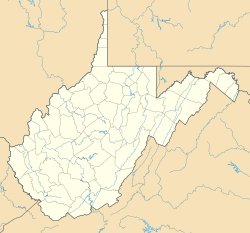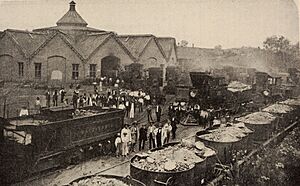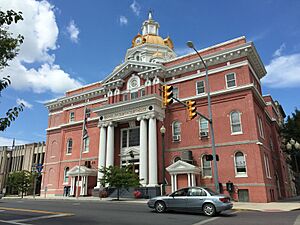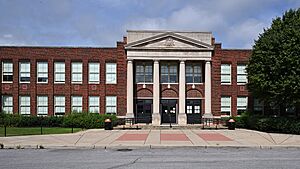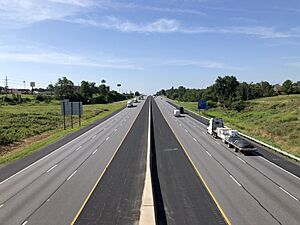Martinsburg, West Virginia facts for kids
Quick facts for kids
Martinsburg, West Virginia
|
|||
|---|---|---|---|
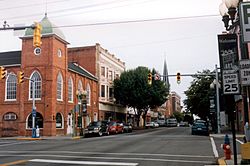
Downtown Martinsburg Historic District
|
|||
|
|||
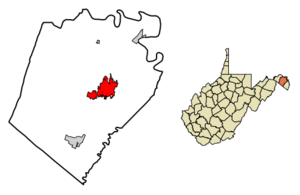
Location of Martinsburg in Berkeley County, West Virginia
|
|||
| Country | United States | ||
| State | West Virginia | ||
| County | Berkeley | ||
| Area | |||
| • City | 6.65 sq mi (17.22 km2) | ||
| • Land | 6.63 sq mi (17.17 km2) | ||
| • Water | 0.02 sq mi (0.04 km2) | ||
| Elevation | 495 ft (151 m) | ||
| Population
(2020)
|
|||
| • City | 18,773 | ||
| • Estimate
(2019)
|
18,835 | ||
| • Density | 2,632.18/sq mi (1,016.31/km2) | ||
| • Urban | 43,441 | ||
| • Metro | 260,070 (US: 167th) | ||
| Time zone | UTC−5 (EST) | ||
| • Summer (DST) | UTC−4 (EDT) | ||
| ZIP codes |
25401–25405
|
||
| Area code(s) | 304 681 | ||
| FIPS code | 54-52060 | ||
| GNIS feature ID | 2390615 | ||
| Website | City of Martinsburg | ||
Martinsburg is a city in West Virginia, United States. It's the main city in Berkeley County. In 2020, about 18,773 people lived there. This makes Martinsburg the biggest city in the Eastern Panhandle of West Virginia. It is also the sixth-largest city in the entire state. Martinsburg is part of a larger area that includes Hagerstown, Maryland. This bigger area had about 293,844 people in 2020.
Contents
History
Martinsburg was officially started in December 1778. This was during the American Revolutionary War. A general named Adam Stephen founded the town. He named it after Colonel Thomas Bryan Martin, who was a nephew of Lord Fairfax. The town is located along Tuscarora Creek.
The oldest house in Martinsburg is called Aspen Hall. It's a large, old house built in 1745. The people who lived there were important in the area's farming, religion, transportation, and politics. Important events from the French and Indian War, the American Revolution, and the Civil War happened on its land. Three of the original buildings are still standing today. This includes a rare blockhouse from Mendenhall's Fort.
The first United States post office in what is now West Virginia opened in Martinsburg in 1792. At that time, Martinsburg was still part of Virginia.
The Baltimore and Ohio Railroad (B&O) reached Martinsburg in 1842. The Baltimore and Ohio Railroad Martinsburg Shops were built in 1849. They were rebuilt after the Civil War.
In 1856, a man named Robert Brown escaped slavery in Martinsburg. He swam across the freezing Potomac River on a horse. After a long journey, he reached Philadelphia with help from the Underground Railroad. This was a secret network that helped enslaved people find freedom. Robert Brown was looking for his wife and four children, who had been sold.
The Civil War Years
In 1854, a girl named Belle Boyd moved to Martinsburg with her family. She later became a famous spy for the Confederate side during the Civil War. When Union soldiers took over Martinsburg, they tried to put a Union flag on the Boyd family home. Belle's mother refused. When a soldier threatened her mother, Belle shot him. She was found innocent.
Belle soon started spying. She sent information to Confederate generals like Thomas "Stonewall" Jackson and J.E.B. "Jeb" Stuart. Eliza Corsey, a family slave whom Belle had taught to read, often helped her. In 1863, the Union Army arrested Belle in Martinsburg and put her in prison. The house Belle's father built is now the Berkeley County Museum. It is also known as the Belle Boyd House.
After the War
During the Civil War, people in West Virginia were divided. About half of their soldiers fought for the Confederate army. A new state was created in western Virginia. It was approved by Congress and President Lincoln. This new state, West Virginia, joined the Union on June 20, 1863.
The city of Martinsburg was officially made a city by the new West Virginia Legislature on March 30, 1868.
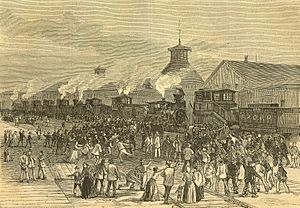
Martinsburg became a key place for the railroad industry and its workers. The Great Railroad Strike of 1877 started here on July 14, 1877. This was a big protest by railroad workers. The governor had to call in federal troops to stop the protests. By then, the strike had spread across the country.
Telephone service came to Martinsburg in 1883. In 1889, electricity started to power the city.
The Interwoven Mills, which made textiles, began working in Martinsburg in 1891. The Apollo Civic Theatre was finished in 1913.
World War I and Beyond
More than a thousand men from Berkeley County fought in World War I. Forty-one of them died, and twenty-one were wounded. A monument to these soldiers was put up in Martinsburg in 1925.
During World War II, the Newton D. Baker Hospital in Martinsburg treated thousands of wounded soldiers. In 1946, this military hospital became part of the Veterans Administration (VA). The VA Medical Center in Martinsburg still helps United States veterans today.
Starting in the late 1940s, many factories in Martinsburg closed down. This was a big problem for the local economy. Jobs moved to other parts of the country and then to other countries.
Geography
Location and Area
Martinsburg is about 18 miles (29 km) southwest of Hagerstown, Maryland. It's also about 73 miles (117 km) west of Baltimore and 63 miles (101 km) northwest of Washington, D.C.. U.S. Route 11 goes through the middle of town. Interstate 81 runs along the north side of the city.
Martinsburg is 212 miles (341 km) from Charleston, the capital of West Virginia. But it's closer to five other state capitals:
- Harrisburg, Pennsylvania: 80 miles (129 km)
- Annapolis, Maryland: 85 miles (137 km)
- Dover, Delaware: 132 miles (212 km)
- Richmond, Virginia: 135 miles (217 km)
- Trenton, New Jersey: 179 miles (288 km)
The city covers a total area of 6.67 square miles (17.28 km²). Most of this is land, with only a small amount of water.
Climate and Weather
Martinsburg has four clear seasons. It's in a spot where two climate types meet: humid subtropical and humid continental.
- Winters are cool to cold. The average temperature in January is 32.4°F (0.2°C). It snows about 26.1 inches (66 cm) each year.
- Summers are hot and humid. The average temperature in July is 75.7°F (24.3°C). It gets hotter than 90°F (32°C) about 27 days a year.
- Rainfall is moderate. Winter is the driest time, and May through July are the wettest.
- The coldest temperature ever recorded was -19°F (-28°C) in 1912. The hottest was 112°F (44°C) in 1936.
| Climate data for Martinsburg, West Virginia (Eastern West Virginia Regional Airport), 1991−2020 normals, extremes 1891−present | |||||||||||||
|---|---|---|---|---|---|---|---|---|---|---|---|---|---|
| Month | Jan | Feb | Mar | Apr | May | Jun | Jul | Aug | Sep | Oct | Nov | Dec | Year |
| Record high °F (°C) | 80 (27) |
83 (28) |
90 (32) |
101 (38) |
100 (38) |
110 (43) |
112 (44) |
108 (42) |
103 (39) |
98 (37) |
86 (30) |
78 (26) |
112 (44) |
| Mean maximum °F (°C) | 64.0 (17.8) |
65.9 (18.8) |
76.0 (24.4) |
85.1 (29.5) |
89.7 (32.1) |
93.8 (34.3) |
96.6 (35.9) |
94.3 (34.6) |
90.6 (32.6) |
83.6 (28.7) |
73.7 (23.2) |
64.7 (18.2) |
97.4 (36.3) |
| Mean daily maximum °F (°C) | 41.3 (5.2) |
44.7 (7.1) |
53.5 (11.9) |
65.4 (18.6) |
74.0 (23.3) |
82.4 (28.0) |
86.9 (30.5) |
85.0 (29.4) |
78.1 (25.6) |
66.7 (19.3) |
55.1 (12.8) |
44.8 (7.1) |
64.8 (18.2) |
| Daily mean °F (°C) | 32.4 (0.2) |
35.0 (1.7) |
42.8 (6.0) |
53.6 (12.0) |
62.5 (16.9) |
71.1 (21.7) |
75.7 (24.3) |
73.8 (23.2) |
66.7 (19.3) |
55.2 (12.9) |
44.6 (7.0) |
36.0 (2.2) |
54.1 (12.3) |
| Mean daily minimum °F (°C) | 23.5 (−4.7) |
25.3 (−3.7) |
32.2 (0.1) |
41.8 (5.4) |
51.0 (10.6) |
59.8 (15.4) |
64.5 (18.1) |
62.5 (16.9) |
55.3 (12.9) |
43.7 (6.5) |
34.2 (1.2) |
27.1 (−2.7) |
43.4 (6.3) |
| Mean minimum °F (°C) | 4.3 (−15.4) |
9.5 (−12.5) |
15.5 (−9.2) |
27.2 (−2.7) |
36.6 (2.6) |
46.7 (8.2) |
53.7 (12.1) |
52.2 (11.2) |
41.3 (5.2) |
29.2 (−1.6) |
19.3 (−7.1) |
12.0 (−11.1) |
2.1 (−16.6) |
| Record low °F (°C) | −19 (−28) |
−13 (−25) |
−3 (−19) |
19 (−7) |
26 (−3) |
36 (2) |
41 (5) |
38 (3) |
29 (−2) |
17 (−8) |
6 (−14) |
−12 (−24) |
−19 (−28) |
| Average precipitation inches (mm) | 2.60 (66) |
2.14 (54) |
3.42 (87) |
3.36 (85) |
4.05 (103) |
3.85 (98) |
3.78 (96) |
3.02 (77) |
4.03 (102) |
2.99 (76) |
2.73 (69) |
3.00 (76) |
38.97 (990) |
| Average snowfall inches (cm) | 9.0 (23) |
7.2 (18) |
4.6 (12) |
0.4 (1.0) |
0.0 (0.0) |
0.0 (0.0) |
0.0 (0.0) |
0.0 (0.0) |
0.0 (0.0) |
0.0 (0.0) |
1.1 (2.8) |
3.8 (9.7) |
26.1 (66) |
| Average precipitation days (≥ 0.01 in) | 10.0 | 8.9 | 11.0 | 11.0 | 13.0 | 11.3 | 10.6 | 9.1 | 9.4 | 9.0 | 8.5 | 9.5 | 121.3 |
| Average snowy days (≥ 0.1 in) | 3.7 | 2.1 | 1.7 | 0.2 | 0.0 | 0.0 | 0.0 | 0.0 | 0.0 | 0.0 | 0.5 | 2.1 | 10.3 |
| Source: NOAA (snow 1981–2010) | |||||||||||||
People and Population
| Historical population | |||
|---|---|---|---|
| Census | Pop. | %± | |
| 1850 | 2,190 | — | |
| 1860 | 3,364 | 53.6% | |
| 1870 | 4,863 | 44.6% | |
| 1880 | 6,335 | 30.3% | |
| 1890 | 7,226 | 14.1% | |
| 1900 | 7,564 | 4.7% | |
| 1910 | 10,698 | 41.4% | |
| 1920 | 12,515 | 17.0% | |
| 1930 | 14,857 | 18.7% | |
| 1940 | 15,063 | 1.4% | |
| 1950 | 15,621 | 3.7% | |
| 1960 | 15,179 | −2.8% | |
| 1970 | 14,626 | −3.6% | |
| 1980 | 13,063 | −10.7% | |
| 1990 | 14,073 | 7.7% | |
| 2000 | 14,972 | 6.4% | |
| 2010 | 17,227 | 15.1% | |
| 2020 | 18,773 | 9.0% | |
| U.S. Decennial Census | |||
2020 Census Information
In 2020, there were 18,777 people living in Martinsburg. They lived in 7,179 homes. The city had about 2,592 people per square mile.
- Most people (79.9%) were White.
- About 13.9% were African American.
- About 1.3% were Asian.
- About 3.1% were of two or more races.
- About 4.8% of the population was Hispanic or Latino.
The average household income in 2019 was $42,835. The income per person was $24,970. About 29.5% of the people lived in poverty. Most homes (88.5%) had a computer, and 77.9% had high-speed internet.
2010 Census Information
In 2010, there were 17,227 people living in Martinsburg. There were 7,293 households and 4,106 families.
- The average age in the city was 37 years old.
- 23.3% of residents were under 18.
- 13.4% were 65 or older.
- The city was 48.8% male and 51.2% female.
Economy and Jobs
Martinsburg has many important employers. Some big private companies include:
- Quad/Graphics
- Ecolab
- Orgill
- Macy's
- FedEx
In 2015, Procter & Gamble announced plans to build a large factory near the city.
The city also has many jobs with the federal government:
- The Internal Revenue Service (IRS) has a large computing center here. It processes most of the country's electronic tax documents.
- U.S. Coast Guard
- Bureau of Alcohol, Tobacco, Firearms, and Explosives
- The Martinsburg VA Medical Center
The 167th Airlift Wing of the West Virginia Air National Guard is also based at the Eastern WV Regional Airport.
From 1912 to 1922, Martinsburg had its own car company called Norwalk. It built cars longer than any other car company in West Virginia.
Sports
Hack Wilson, a famous baseball player, started his career in Martinsburg. He played for the Martinsburg Blue Sox, a local minor-league team. Wilson later set a major league record for runs batted in (RBI) with 191 for the Chicago Cubs in 1930.
After he stopped playing in 1935, Hack Wilson returned to Martinsburg. He played for the town's semi-pro team and opened a recreation and pool hall. He later moved to Baltimore but was buried in Martinsburg after he passed away in 1948.
Education
Martinsburg has many schools for students of all ages.
Elementary and Intermediate Schools
- Rocky Knoll Adventist School
- Back Creek Valley Elementary
- Bedington Elementary
- Berkeley Heights Elementary
- Bunker Hill Elementary
- Burke Street Elementary
- Gerrardstown Elementary
- Hedgesville Elementary
- Inwood Elementary
- Marlowe Elementary
- Opequon Elementary
- Rosemont Elementary
- Spring Mills Elementary
- Tuscarora Elementary
- Valley View Elementary
- Winchester Avenue Elementary
- Mountain Ridge Intermediate
- Potomac Intermediate
- Orchard View Intermediate
- Mill Creek Intermediate
- Eagle School Intermediate
- Tomahawk Intermediate
- St. Joseph Catholic School
Middle Schools
- North Middle
- South Middle
- Spring Mills Middle
- Hedgesville Middle
- Mountain Ridge Middle
- Musselman Middle
High Schools
- Martinsburg High School
- Musselman High School
- Hedgesville High School
- Spring Mills High School
Colleges and Universities
- Blue Ridge Community and Technical College, Martinsburg
- James Rumsey Technical Institute, Martinsburg
- Shepherd University-Martinsburg
- Valley College of Technology, Martinsburg Campus
Media
Print and Radio
Martinsburg has a daily newspaper called The Journal. The city also has a magazine that comes out every two months called Around the Panhandle.
Several radio stations broadcast from Martinsburg:
- WEPM/1340 AM
- WRNR/740 AM
- WICL/95.9 FM
- WLTF/97.5 FM
- WVEP/88.9 FM
Television
Martinsburg is home to these TV channels:
- W08EE-D Channel 8 (West Virginia Public Broadcasting)
- WWPX 60 (ION)
Martinsburg was the setting for an episode of X-Files called "Small Potatoes". It was also the setting for the reality TV show Gypsy Sisters on TLC.
Transportation
Roads and Highways
Martinsburg has several important highways.
- Interstate 81 is the main highway running north and south. It connects Martinsburg to Hagerstown and Harrisburg to the north. To the south, it goes to Winchester and Roanoke.
- U.S. Route 11 used to be the main north-south highway. Now it serves local traffic and goes through downtown Martinsburg.
- West Virginia Route 9 is the main east-west highway. East of Martinsburg, it's an expressway that connects to Charles Town and Leesburg. West of Martinsburg, it goes to Berkeley Springs.
- West Virginia Route 45 goes west into the countryside and east to Shepherdstown.
Public Transportation
- Amtrak offers train service to Martinsburg on its Capitol Limited route, which runs between Washington, D.C., and Chicago. The train station is downtown.
- MARC, Maryland's commuter train system, runs trains to Martinsburg on weekdays. These trains go to Washington Union Station in Washington, D.C..
- The Eastern Panhandle Transit Authority (EPTA) runs public buses in Martinsburg and the nearby counties.
The Eastern WV Regional Airport, south of the city, is used for smaller planes. The Shepherd Field Air National Guard Base is also at this airport. For commercial flights, the closest airport is Hagerstown Regional Airport, about 25 miles (40 km) north. The closest international airport is Washington Dulles International Airport, about 60 miles (97 km) east.
Healthcare
Martinsburg has two hospitals:
- Berkeley Medical Center
- Martinsburg Veterans Affairs Medical Center (VA Medical Center)
Notable People
Many interesting people have connections to Martinsburg:
- Tyson Bagent — a quarterback for the Chicago Bears football team.
- Newton D. Baker — a former Secretary of War and Mayor of Cleveland.
- Harold H. Bender (1882–1951) — a professor at Princeton University.
- Belle Boyd (1844–1900) — a famous Confederate spy during the Civil War.
- Scott Bullett — a former baseball player for the Pittsburgh Pirates and Chicago Cubs.
- Vicky Bullett — an Olympic gold medalist in women's basketball.
- Harry Flood Byrd Sr. — a U.S. Senator and Governor of Virginia.
- Robert Lee Castleman — a Grammy-winning singer and songwriter.
- J.R. Clifford (1848-1933) — the first African-American attorney in West Virginia.
- Charles James Faulkner — a U.S. Senator from West Virginia.
- Karl Hess — a writer and political activist.
- Corey Hill — a UFC fighter.
- Walter Dean Myers — a well-known author.
- Mary Elizabeth Price (1877–1965) — an impressionist painter.
- Absalom Willis Robertson — a U.S. Senator from Virginia.
- Anthony Senecal — a butler for Donald Trump.
- Mary Ann Shaffer (1934–2008) — a writer, editor, and librarian.
- David Hunter Strother (also known as Porte Crayon) — an artist.
- Fulton Walker — a former football player for the Miami Dolphins.
- Trevon Wesco — a tight end for the Tennessee Titans football team.
- Garland Wilson (1909–1954) — a jazz pianist.
- Hack Wilson — a Hall of Fame baseball player.
See also
 In Spanish: Martinsburg (Virginia Occidental) para niños
In Spanish: Martinsburg (Virginia Occidental) para niños




